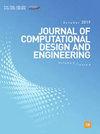基于梯度下降的 RNA 进化算法用于函数优化
IF 4.8
2区 工程技术
Q1 COMPUTER SCIENCE, INTERDISCIPLINARY APPLICATIONS
引用次数: 0
摘要
优化具有多个独立变量的数值函数是一项重大挑战,在过程控制系统、数据拟合和工程设计中有着大量实际应用。虽然 RNA 遗传算法在函数优化方面具有明显的优势,包括收敛速度快,但其精度较低,而且很容易陷入局部最优状态。为了解决这些问题,我们提出了一种新的启发式算法,即基于梯度下降的 RNA 遗传算法。具体来说,自适应矩估计(Adam)被用作突变算子,以提高算法的局部发展能力。此外,受 RNA 分子内环结构的启发,还引入了两个新算子:内环交叉算子和内环突变算子。这些算子增强了算法在进化初期的全局探索能力,使其能够摆脱局部最优状态。该算法由两个阶段组成:进化前阶段采用 RNA 遗传算法识别最优区域附近的个体;进化后阶段采用自适应梯度下降突变进一步提高解决方案的质量。与目前解决函数优化问题的先进算法相比,亚当 RNA-GA 算法能产生更好的最优解。在 17 个基准函数中,Adam RNA-GA 与 RNA 遗传算法(RNA-GA)和遗传算法(GA)进行了比较,根据 Friedman 检验,Adam RNA-GA 以平均排名 1.58 的最佳成绩排名第一。在 CEC2017 套件的 29 个函数集合中,与非洲秃鹫优化算法 (AVOA)、蜣螂优化算法 (DBO)、鲸鱼优化算法 (WOA) 和灰狼优化算法 (GWO) 等启发式算法相比,根据 Friedman 检验,Adam RNA-GA 以平均排名 1.724 的最佳结果排名第一。我们的算法不仅比 RNA-GA 有了显著改进,而且在当前各种先进的函数优化算法中表现出色,实现了高精度的函数优化。本文章由计算机程序翻译,如有差异,请以英文原文为准。
An RNA Evolutionary Algorithm Based on Gradient Descent for Function Optimization
The optimization of numerical functions with multiple independent variables was a significant challenge with numerous practical applications in process control systems, data fitting, and engineering designs. Although RNA genetic algorithms offer clear benefits in function optimization, including rapid convergence, they have low accuracy and can easily become trapped in local optima. To address these issues, a new heuristic algorithm was proposed, a gradient descent-based RNA genetic algorithm. Specifically, adaptive moment estimation (Adam) was employed as a mutation operator to improve the local development ability of the algorithm. Additionally, two new operators inspired by the inner-loop structure of RNA molecules were introduced: an inner-loop crossover operator and an inner-loop mutation operator. These operators enhance the global exploration ability of the algorithm in the early stages of evolution and enable it to escape from local optima. The algorithm consists of two stages: a pre-evolutionary stage that employs RNA genetic algorithms to identify individuals in the vicinity of the optimal region and a post-evolutionary stage that applies a adaptive gradient descent mutation to further enhance the solution's quality. When compared with the current advanced algorithms for solving function optimization problems, Adam RNA-GA produced better optimal solutions. In comparison with RNA Genetic Algorithm (RNA-GA) and Genetic Algorithm (GA) across 17 benchmark functions, Adam RNA-GA ranked first with the best result of an average rank of 1.58 according to the Friedman test. In the set of 29 functions of the CEC2017 suite, compared with heuristic algorithms such as African Vulture Optimization Algorithm (AVOA), Dung Beetle Optimization (DBO), Whale Optimization Algorithm (WOA), and Grey Wolf Optimizer (GWO), Adam RNA-GA ranked first with the best result of an average rank of 1.724 according to the Friedman test. Our algorithm not only achieved significant improvements over RNA-GA but also performed excellently among various current advanced algorithms for solving function optimization problems, achieving high precision in function optimization.
求助全文
通过发布文献求助,成功后即可免费获取论文全文。
去求助
来源期刊

Journal of Computational Design and Engineering
Computer Science-Human-Computer Interaction
CiteScore
7.70
自引率
20.40%
发文量
125
期刊介绍:
Journal of Computational Design and Engineering is an international journal that aims to provide academia and industry with a venue for rapid publication of research papers reporting innovative computational methods and applications to achieve a major breakthrough, practical improvements, and bold new research directions within a wide range of design and engineering:
• Theory and its progress in computational advancement for design and engineering
• Development of computational framework to support large scale design and engineering
• Interaction issues among human, designed artifacts, and systems
• Knowledge-intensive technologies for intelligent and sustainable systems
• Emerging technology and convergence of technology fields presented with convincing design examples
• Educational issues for academia, practitioners, and future generation
• Proposal on new research directions as well as survey and retrospectives on mature field.
 求助内容:
求助内容: 应助结果提醒方式:
应助结果提醒方式:


